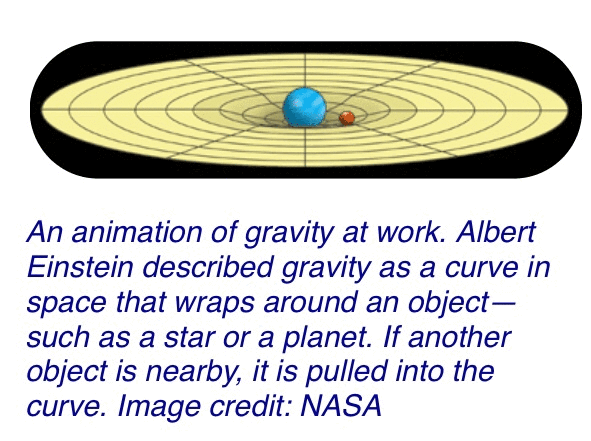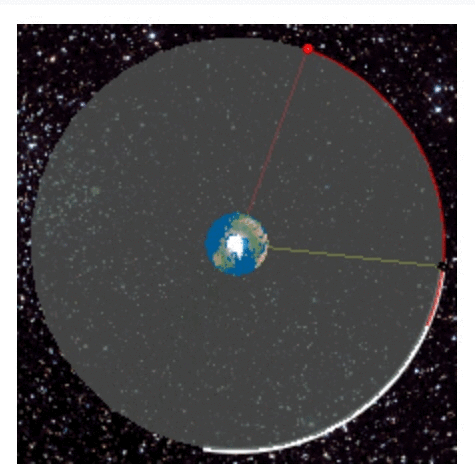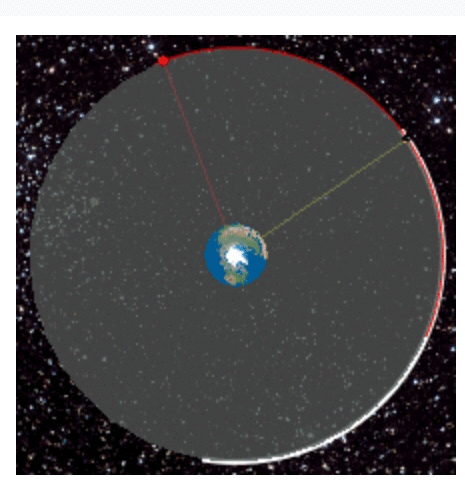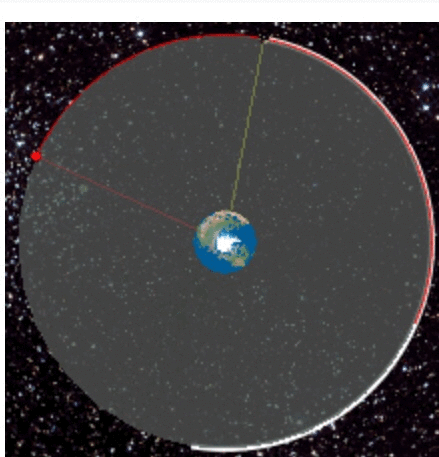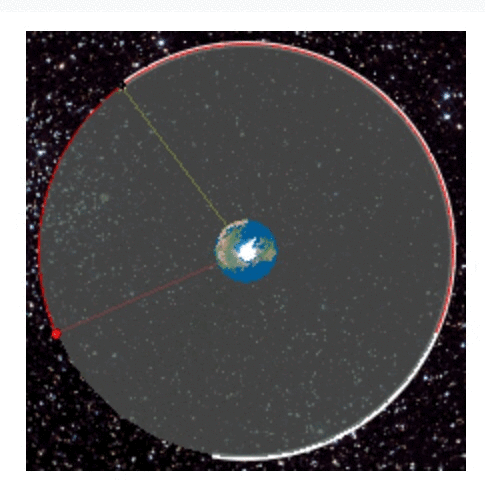It looks like you're using an Ad Blocker.
Please white-list or disable AboveTopSecret.com in your ad-blocking tool.
Thank you.
Some features of ATS will be disabled while you continue to use an ad-blocker.
share:
a reply to: Phage
But a geostationary satellte doesnt move relative to the Earth, Phage. Yet you say it falling around the Earth.
Wow.
Variations of what? We are discussing geostationary orbits. They cannot exist.
The former is correct, the latter is incorrect.
But a geostationary satellte doesnt move relative to the Earth, Phage. Yet you say it falling around the Earth.
Wow.
What about other variations?
Variations of what? We are discussing geostationary orbits. They cannot exist.
edit on 17-8-2019 by InfiniteTrinity because: (no reason
given)
a reply to: InfiniteTrinity
Around the Earth's center of gravity, yes.
Yet you say it falling around the Earth.
Orbits.
Variations of what?
Because the Earth rotates?
We are discussing geostationary orbits. They cannot exist.
a reply to: InfiniteTrinity
You
Wrong. A geostationary satellite falls about Earth’s axis at about 1.91 mi/s, around 22,236 mi above earth. Some satellites “fall” at a speed that makes them appear to travel east relative to the earth’s surface. Some satellites travel at a speed that makes them appear to travel west relative to earth’s surface. Geostationary satellites are in the middle in terms of speed and height. They have the appearance of no motion from the equator. But they are still circling the earth’s axis along the curve of the gravity well.
You
But it is geostationary and doesnt fall around the planet.
Wrong. A geostationary satellite falls about Earth’s axis at about 1.91 mi/s, around 22,236 mi above earth. Some satellites “fall” at a speed that makes them appear to travel east relative to the earth’s surface. Some satellites travel at a speed that makes them appear to travel west relative to earth’s surface. Geostationary satellites are in the middle in terms of speed and height. They have the appearance of no motion from the equator. But they are still circling the earth’s axis along the curve of the gravity well.
a reply to: Phage
You mean a point in space you can draw a line to? This is a description of a path, not an explanation. How does it maintain its curved trajectory through space. An object has to fall around curvature to do that.
Around the Earth's center of gravity, yes.
You mean a point in space you can draw a line to? This is a description of a path, not an explanation. How does it maintain its curved trajectory through space. An object has to fall around curvature to do that.
a reply to: InfiniteTrinity
www.abovetopsecret.com...
I told you that.
How does it maintain its curved trajectory through space
www.abovetopsecret.com...
a reply to: Phage
Yes and after that other posts were made that left you with this,
Can you answer the question now, Phage?
And can you define "falling"?
If not you might aswell give up now.
Yes and after that other posts were made that left you with this,
How does it maintain its curved trajectory through space. An object has to fall around curvature to do that.
Can you answer the question now, Phage?
And can you define "falling"?
If not you might aswell give up now.
originally posted by: InfiniteTrinity
a reply to: neutronflux
But according to Phage it travels around the Earth.
You keep changing your argument. Your early claim was:
And again, it is not in an orbit. Its geostationary. How can you make this mistake 50 times in a row?
Which you are wrong. A geostationary/ geosynchronous satellites are in orbit. Sorry if you don’t like the general term “around” in a causal forum.
That doesn’t mean geostationary/ geosynchronous satellites are not in earth’s orbit. See, problem solved for your intellectually dishonest argument. You don’t have to use “around” to say geostationary/ geosynchronous satellites are in earth orbit.
Which would be in line with the more specific term of orbit as applied to satellites
Orbit
en.m.wikipedia.org...
In physics, an orbit is the gravitationally curved trajectory of an object,[1] such as the trajectory of a planet around a star or a natural satellite around a planet. Normally, orbit refers to a regularly repeating trajectory, although it may also refer to a non-repeating trajectory. To a close approximation, planets and satellites follow elliptic orbits, with the central mass being orbited at a focal point of the ellipse,[2] as described by Kepler's laws of planetary motion.
edit on 17-8-2019 by neutronflux because: Added and fixed
edit on 17-8-2019 by neutronflux because: Fixed
more
a reply to: InfiniteTrinity
The question was answered. The angular momentum of any object in any orbit is determined by gravity. Do you require a definition of angular momentum?
Can you answer the question now, Phage?
The question was answered. The angular momentum of any object in any orbit is determined by gravity. Do you require a definition of angular momentum?
Acceleration due to gravity.
And can you define "falling"?
a reply to: neutronflux
They are not in Earth orbit. It has to move relative to Earth in order to qualify as orbit per its definition no matter how far you bend over backwards.
Can you now explain how it maintains a curved trajectory through space, without falling around Earth curvature?
Can you define falling?
That doesn’t mean geostationary/ geosynchronous satellites are not in earth’s orbit. See, problem solve for your intellectually dishonest argument. You don’t have to use “around” to say geostationary/ geosynchronous satellites are in earth orbit.
They are not in Earth orbit. It has to move relative to Earth in order to qualify as orbit per its definition no matter how far you bend over backwards.
Can you now explain how it maintains a curved trajectory through space, without falling around Earth curvature?
Can you define falling?
originally posted by: InfiniteTrinity
a reply to: neutronflux
That doesn’t mean geostationary/ geosynchronous satellites are not in earth’s orbit. See, problem solve for your intellectually dishonest argument. You don’t have to use “around” to say geostationary/ geosynchronous satellites are in earth orbit.
They are not in Earth orbit. It has to move relative to Earth in order to qualify as orbit per its definition no matter how far you bend over backwards.
Can you now explain how it maintains a curved trajectory through space, without falling around Earth curvature?
Can you define falling?
I was quoting “fall” in a response to how you used “fall” in your post. I don’t really like using the term “fall” in this discussion of orbit.
Again...
You
You guys are hilarious. You keep posting the same dumb contradiction I debunked about 40 times now.
The only thing dumb is that you cannot realize the earth’s rotation has nothing to do with earth’s gravity well. And it’s ”dumb” that you think a satellite cannot be in orbit because it is at a height and speed that matches the earth’s rotation.
First off, the earth’s rotation has nothing to do with the ability of a satellite to orbit. In reality, a satellite does not orbit the center of the earth. A satellite orbits the center of Earth’s gravity well. An orbiting satellite could careless if the earth was rotating, and at what speed.
What is gravity?
spaceplace.nasa.gov...
Second: Why can you not get through your head a geostationary/ geosynchronous still obits the earth. It’s just at a speed that keeps it above a specific point and n earth. But a geostationary / geosynchronous satellite is still traveling around earth’s gravity well.
Geostationary orbit
en.m.wikipedia.org...
A geostationary orbit, often referred to as a geosynchronous equatorial orbit[1] (GEO), is a circular geosynchronous orbit 35,786 km (22,236 mi) above Earth's equator and following the direction of Earth's rotation. An object in such an orbit appears motionless, at a fixed position in the sky, to ground observers. Communications satellites and weather satellites are often placed in geostationary orbits, so that the satellite antennas (located on Earth) that communicate with them do not have to rotate to track them, but can be pointed permanently at the position in the sky where the satellites are located. Using this characteristic, ocean-color monitoring satellites with visible and near-infrared light sensors (e.g. GOCI) can also be operated in geostationary orbit in order to monitor sensitive changes of ocean environments.
Yes, from the earth’s surface. A geostationary satellite appears to be “fixed”. But that same satellite is traveling the “curve” of earth’s gravity well. Orbiting around the center of earth’s gravity well
a reply to: neutronflux
I didnt make any such argument.
Report back when you say anything relevant.
The only thing dumb is that you cannot realize the earth’s rotation has nothing to do with earth’s gravity well.
I didnt make any such argument.
Report back when you say anything relevant.
a reply to: InfiniteTrinity
Any object in any orbit (including a geostationary orbit) follows a curved path due to the influence of gravity. All falling objects follow a curved path unless they possess a radial velocity parallel to the direction of acceleration due to gravity. Apart from that very special circumstance, the resultant path is always curved. Galileo demonstrated that quite effectively quite a while ago.
Yes.
Does a geostationary satellite encounter a curve in the direction of gravity,
Any object in any orbit (including a geostationary orbit) follows a curved path due to the influence of gravity. All falling objects follow a curved path unless they possess a radial velocity parallel to the direction of acceleration due to gravity. Apart from that very special circumstance, the resultant path is always curved. Galileo demonstrated that quite effectively quite a while ago.
Incorrect. A geostationary satellite is moving at an angular velocity of 15º hour. It has angular momentum.
There is no angular momentum that applies to the relevant frame of reference here.
edit on 8/17/2019 by Phage because: (no reason given)
originally posted by: InfiniteTrinity
a reply to: Phage
Do you require a definition of angular momentum?
What angular momentum. There is no angular momentum that applies to the relevant frame of reference here.
Unless you use the earth’s axis.
Geostationary orbit
en.m.wikipedia.org...
If you go by the definition of Angular momentum, use the earth’s axis as the origin, there is Angular momentum for a geostationary/geosynchronous satellite.
Angular momentum
en.m.wikipedia.org...
In three dimensions, the angular momentum for a point particle is a pseudovector r × p, the cross product of the particle's position vector r (relative to some origin) and its momentum vector; the latter is p = mv in Newtonian mechanics.
edit on 17-8-2019 by neutronflux because: Added and fixed
originally posted by: InfiniteTrinity
a reply to: neutronflux
The only thing dumb is that you cannot realize the earth’s rotation has nothing to do with earth’s gravity well.
I didnt make any such argument.
Report back when you say anything relevant.
Then clearly state what your argument is concerning why a geostationary/ geosynchronous is not in earth orbit.
I am guessing you will not because your are intellectually dishonest.
You would rather just keep moving the goalposts, and hope people don’t bother with what you have posted in the past.
edit on 17-8-2019 by
neutronflux because: Added and fixed
new topics
-
Ukraine hit 300 miles into Russia
World War Three: 3 hours ago -
Who is going to be number three
US Political Madness: 3 hours ago -
KAMALA HARRIS Told Reporters Homes of Gun Owners Will Be Searched to Ensure Compliance.
2024 Elections: 6 hours ago -
Dude Comes Face To Face With A Bear! Short Video
General Chit Chat: 6 hours ago -
Fact Check: Tim Walz Repeats Lie about Trump Creating ‘Monitor’ for Pregnancies
2024 Elections: 6 hours ago -
March 12 2024 city meeting, Springfield Ohio city manager says "I’ve heard about it too"
US Political Madness: 6 hours ago -
Color hue eye test…Super cool…
Health & Wellness: 7 hours ago -
Another Attempt (?) - Police Find Explosives in Car Near Trump’s Long Island Rally
US Political Madness: 8 hours ago -
Sweet Home Built RC plane-NGAD inspired
ATS Skunk Works: 9 hours ago -
Order is Very Important...
Short Stories: 9 hours ago
top topics
-
KAMALA HARRIS Told Reporters Homes of Gun Owners Will Be Searched to Ensure Compliance.
2024 Elections: 6 hours ago, 18 flags -
Routh is a patsy groomed by the CIA and trained at Fort Bragg"
Political Conspiracies: 10 hours ago, 16 flags -
Who is going to be number three
US Political Madness: 3 hours ago, 15 flags -
Trump threatens feedom and meanwhile in California
US Political Madness: 11 hours ago, 14 flags -
Another Attempt (?) - Police Find Explosives in Car Near Trump’s Long Island Rally
US Political Madness: 8 hours ago, 12 flags -
March 12 2024 city meeting, Springfield Ohio city manager says "I’ve heard about it too"
US Political Madness: 6 hours ago, 8 flags -
Color hue eye test…Super cool…
Health & Wellness: 7 hours ago, 8 flags -
Multiple drones have struck Toropets, Russia, causing a huge explosion
World War Three: 11 hours ago, 8 flags -
Fact Check: Tim Walz Repeats Lie about Trump Creating ‘Monitor’ for Pregnancies
2024 Elections: 6 hours ago, 6 flags -
Dude Comes Face To Face With A Bear! Short Video
General Chit Chat: 6 hours ago, 6 flags
active topics
-
There Must Be Something to Hide!
Political Conspiracies • 66 • : Flyingclaydisk -
UK Channel 4 programme The Trump Heist
Mainstream News • 48 • : Justoneman -
Cell phones exploding in Lebanon mass casualties
Middle East Issues • 47 • : bluemooone44 -
Another Attempt (?) - Police Find Explosives in Car Near Trump’s Long Island Rally
US Political Madness • 16 • : DontTreadOnMe -
The Why Files - YouTube channel
General Chit Chat • 10 • : mblahnikluver -
Who is going to be number three
US Political Madness • 43 • : DontTreadOnMe -
Fact Check: Tim Walz Repeats Lie about Trump Creating ‘Monitor’ for Pregnancies
2024 Elections • 2 • : Dalamax -
Trump threatens feedom and meanwhile in California
US Political Madness • 27 • : Vermilion -
Ukraine hit 300 miles into Russia
World War Three • 5 • : JadedGhost -
Color hue eye test…Super cool…
Health & Wellness • 20 • : JJproductions

